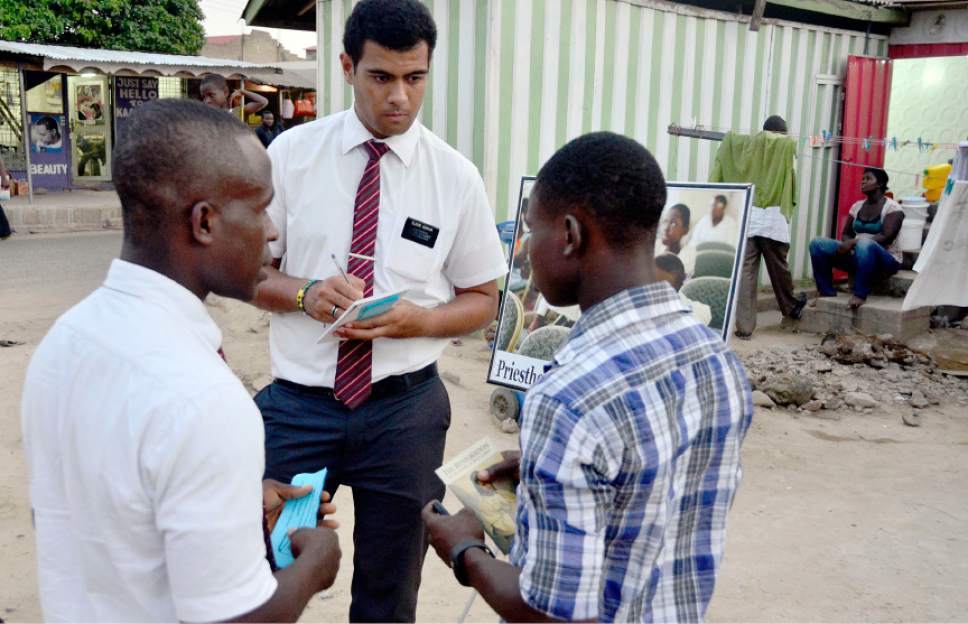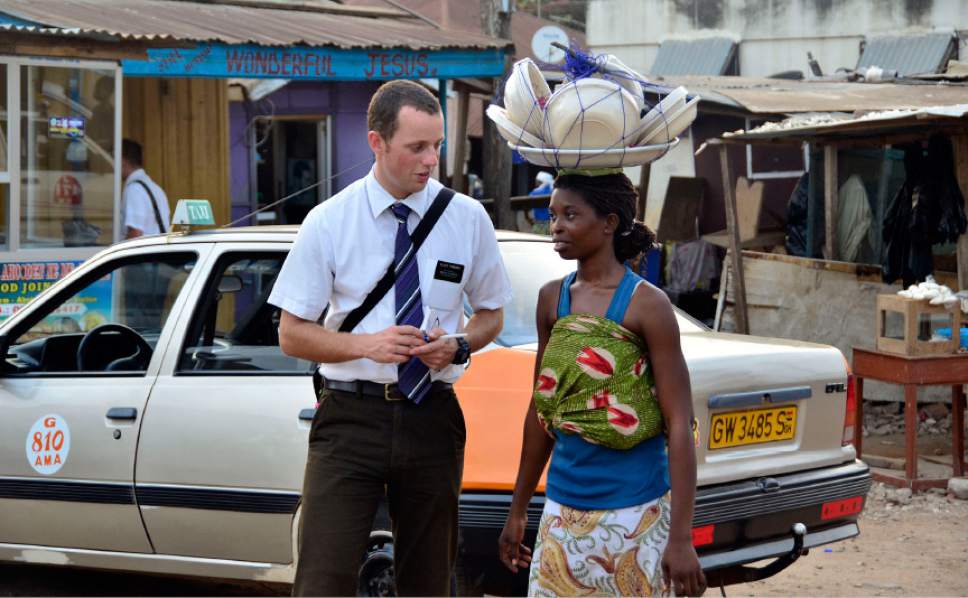This is an archived article that was published on sltrib.com in 2017, and information in the article may be outdated. It is provided only for personal research purposes and may not be reprinted.
At his inaugural news conference in 1995, then-LDS Church President Gordon B. Hinckley quipped that his church's biggest challenge — a "remarkable and wonderful" one to have — was growth, growth and growth.
Mormon leaders might say the same thing 22 years later, but with a twist: The pace of that ever-swelling LDS growth has slowed. In fact, last year's growth rate was the lowest since 1937. The hurdles have evolved from simply keeping up with chapel construction to the ebbs and flows of membership, where to cut and where to expand, when to pull back or plow forward, and how to draw people to the pews and keep them there.
Parts of the United States, Europe, Mexico and Brazil are down, for example, and Africa, the Philippines, and some of Central and South America are up. Mormon congregations near downtown Salt Lake City are closing, while Utah County wards are booming.
Here's how net growth rate for The Church of Jesus Christ of Latter-day Saints is calculated: You take the total membership number reported for 2016 (15,882,417) and subtract the total from 2015 (15,634,199) and you get 248,218. That tallies to an increase of 1.59 percent.
For the first time in decades, independent LDS demographers say, the number of additional members (counting, among other categories, new converts and new children while subtracting deaths and defections) was fewer than 250,000.
So what is causing the drop-off?
In part, overall trends. People may be living longer, but couples are having fewer children — including Mormons.
The Utah-based faith has been in a "period of transition" since 2012, says LDS Church spokesman Eric Hawkins, pointing to "the calling of younger missionaries [and] the use of technology and social media."
It has seen what he describes as "seasonal increases and decreases in church growth in many regions of the world." While Mormonism historically drew most of its converts from Western nations in Britain and Scandinavia, now it has more success in Africa, the Pacific Islands and much of Latin America.
The LDS Church's continued vitality may be measured best by the number of chapels and temples being built. They are not built "in anticipation of growth," Hawkins says, "but instead are constructed once there is sufficient strength [activity and participation] among church members in the region."
Despite a period of "minimal growth" in the Northeast, for example, that area has seen the "construction and dedication of many chapels and two temples (in Philadelphia and Hartford)," Hawkins notes. "In the last year, there have been two stakes [clusters of Mormon congregations] created in that area."
It's a mistake to think this decline is "something peculiar to Mormonism," says sociologist Marie Cornwall, a retired professor from LDS Church-owned Brigham Young University. "There is an anti-institutional attitude afoot."
Modern folks are not necessarily "joiners" anymore, she says. "That started in the 1970s and 1980s with other faiths and now it's hitting more conservative ones like Mormonism — and [institutions] like government and schools."
Nor are employees sticking with a particular job for a long time, Cornwall says. Many have the attitude that "you only participate in a group if you continue to get something out of it."
Individuals are eschewing the LDS Church — indeed, any faith group — for "the same reasons as why others are leaving," she says. "They don't see the relevance."
—
European conundrum • Many multigenerational Mormons today track their family trees back to 19th-century converts in the British Isles and Northern Europe. That's why Utah is awash in, say, Andersons (Sweden) and Andersens (Denmark), for instance.
Europe was a hot spot for missionary efforts well into the 20th century — Hinckley himself toiled as a young proselytizer on the streets of London. So did LDS apostles Jeffrey R. Holland and Quentin L. Cook, who worked side by side as "companions."
Mormon growth in Europe has been stagnant for a couple of decades, so earlier this year, church higher-ups closed or consolidated many congregations, known as wards and branches.
This spring half (seven of 14) LDS congregations in the Antwerp Belgium Stake were closed, says longtime Mormon Wilfried Decoo, a retired BYU professor who lives in Antwerp.
"People understand that discontinuing their small unit was unavoidable, but the emotional toll is immense," Decoo writes in an email. "Most are members who for decades have worked to keep their branch or ward alive, proud to have a Mormon meeting place in their own city, and suddenly it's over. There is not only sadness for the closure as such, sometimes anger."
They also feel a measure of "guilt and depression," Decoo says. That's because visiting LDS leaders and area authorities have been promising that if the members were steadfast and worked hard, their numbers would double.
He says they were told there would be a "second harvest," but no such bumper crop of converts came — despite the members' many sacrifices. Some now doubt the leaders' "inspiration," Decoo says, or feel "blamed for not having done enough."
Brokenhearted members heard nothing of the plans to realign boundaries and shutter their tiny branches until they met at an LDS stake conference in April. When the assembled crowd was asked for its sustaining vote to support the move, every hand went up.
Later, though, a local lay leader reported to Decoo: "My members voted in favor with their right hand and against it with their hearts. And almost all were crying."
Even in Mormonism's capital, fluid demographics have prompted disruptions. Leaders have combined congregations in parts of Salt Lake City while adding wards in the southern Salt Lake Valley.
"Many people with families (including church members) have moved to areas where the cost of living may be more affordable or to be closer to new employment centers or schools," Hawkins says. "Obviously, this impacts the number of church members in both areas. So you'll see a decrease in wards and stakes in one area and an increase in another."
The hope is that the resulting congregations, he says, "have adequate strength, opportunities for service and participation."
Hawkins concedes these are tough decisions.
"There are often strong feelings that accompany the creation or closing of a ward or stake," he says. "It's difficult to experience the loss that's felt when a congregation — which is, at its heart, a community of people — is closed or combined with another. It may mean large distances, the loss of a beloved meeting place, new faces or worshipping with people who don't share the same history and memories. And for others, it may ease some burdens and provide new opportunities. "
Mormon officials feel their pain.
"Church leaders understand these complexities and weigh them carefully as decisions are made about congregations," Hawkins says. "There is no prescribed formula or algorithm for making these decisions."
—
Holding onto members • Beyond simply finding candidates for baptism, Mormon missionaries — as well as their supervisors — want converts who will stick.
For the past 50 years or so, Mormonism has "tended to focus much more on baptisms than on conversions," said LDS sociologist Armand Mauss. "Missionaries try to get commitments to baptismal dates from their investigators beginning with the very earliest contacts. It is not uncommon for only a few weeks to elapse between the first contact and the actual baptism. "
Would-be converts, he says, are "rarely required to make the kinds of investments and sacrifices for their new religion across a timespan that would really test their commitments."
The result? A dropout rate for new converts, Mauss says, of about 75 percent within the first year.
To run an LDS congregation with a lay, male clergy, it requires that men stay long enough to be ordained and advanced in the priesthood. Without an adequate pool of such men, new congregations cannot be created nor existing ones expanded. And without more committed members, it is unlikely that second- and future-generation members (gleaned from converts' children and grandchildren), Mauss says, will remain in the faith, either.
The church has become, he says, "easy come, easy go."
—
Shifting centers of strength • The church is still growing — and by the hundreds of thousands every year — something many denominations nowadays no longer can claim.
But it's not mushrooming in the traditional turf of the U.S., Brazil and Mexico, says independent Mormon demographer Matt Martinich. For the past 15 years, those countries have grown at an annual rate of 2 percent to 5 percent.
In 2016, that range slipped to between 0.9 percent and 2 percent.
In other words, the rate of membership growth there was approximately half the historical average since 2000, Martinich notes, and those nations make up more than 50 percent of the global Mormon membership.
The Colorado Springs researcher blames the decline on "ineffective proselytism tactics, lack of engagement of ordinary members in missionary activity, increasing secularism and materialism, and decades of low convert-retention problems."
As a counterexample, he points to West Africa, where overall membership numbers may be modest but growth rates are surging.
"Good receptivity to LDS teachings, the organization of small branches in lesser-reached urban areas, strong member-missionary involvement in proselytism, and self-sufficiency in meeting regional missionary needs," Martinich says, contribute to an "acceleration in growth."
Christian Anderson, a biostatistician living in San Diego, pins some of the downturn on disaffection.
Looking at the difference between the reported additions and the total, any demographer has to make some assumptions about death rates and membership removals, says Anderson. By assuming a stable percent of deaths annually, he argues that "approximately 30,000 members were excommunicated or resigned in 2016, bringing the total for the last four years to just over 150,000."
The numbers are "based on several fudge factors," Anderson says, "and should only be taken as a rough order-of-magnitude guess."
The LDS Church has acknowledged "periodic increases or decreases" in resignations but insists "the number of people asking to have their names removed from the records of the church has been fewer than one-tenth of 1 percent ... for more than 20 consecutive years."
So Anderson's estimated 30,000 who resigned or were excommunicated in 2016 is far less than the 240,131 converts and 109,246 children of record added to the rolls.
The LDS Church is hardly alone in attracting fewer members or losing ones they already have, says Cincinnati-based Mormon writer and researcher Jana Riess.
Such defections, she says, are "mirrored in almost every religious tradition in America today."
Citing data from Public Religion Research Institute, Riess notes the rise of the so-called "nones." "Throughout American generally," she adds, "39 percent of the millennial generation has no religious affiliation ... the highest it has been in recorded history."
Are Mormon leaders worried?
"Of course" they are, Hawkins says, but they believe in the faith's message and are confident that "the work will continue to grow."
Indeed, he says, the church expects "to reach 16 million members in the very near future."
pstack@sltrib.com Twitter: @religiongal





